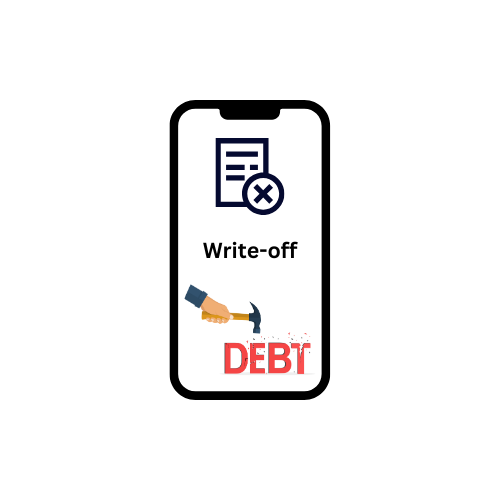A write-off is a reduction of the recognized value of something. In accounting terminology, a write-off refers to reducing the value of an asset while debiting a liabilities account. The general scenarios for business write-offs include unpaid bank loans, losses on stored inventory, and unpaid receivables. Thus, a write off is mandated when an account receivable cannot be collected, when inventory is obsolete, when there is no longer any use for a fixed asset, or when an employee leaves the company and is not willing to pay the company back for a pay advance. Businesses use accounting write-offs to keep track of losses on assets. In a balance sheet, write-offs include a credit to the associated asset account and a debit to an expense account. Expenses will also be entered in the income statement after deducting from the revenues already reported. The general scenarios for business write-offs include unpaid bank loans, losses on stored inventory, and unpaid receivables. Here is a detailed description of each of these cases:
Understanding Write-Offs
In the financial world, a write-off is an accounting action where a company reduces the value of an asset and charges it as an expense. This occurs when the asset is no longer expected to generate future benefits or revenues for the company. Write-offs are a way to recognize that the asset’s value has effectively become zero or close to zero.
Types of Write-Offs
There are several types of write-offs, including:
- Bad Debt Write-Offs: This occurs when a company is unable to collect a debt from a customer. The uncollectible amount is written off as an expense, reducing the accounts receivable balance.
- Inventory Write-Offs: When inventory becomes obsolete, damaged, or unusable, it is written off. The inventory’s value is reduced on the company’s balance sheet, and an expense is recorded.
- Asset Write-Offs: This happens when a fixed asset (like machinery or equipment) no longer provides value to the company and is written off. For example, if equipment is damaged beyond repair, its remaining book value is written off as an expense.
- Account Receivables Write-Offs: Similar to bad debt write-offs, these are specific to uncollectible accounts receivables. The write-off reflects that the company no longer expects to receive payment from certain customers.
Importance of Write-Offs
Write-offs play a crucial role in financial reporting for the following reasons:
- Accurate Financial Statements: Write-offs ensure that the company’s financial statements reflect a true and fair view of its financial position by removing overvalued assets.
- Tax Benefits: In some jurisdictions, companies can deduct write-offs as expenses, reducing their taxable income.
- Compliance: Write-offs ensure compliance with accounting standards and principles, which require companies to report assets at their recoverable amounts.
Accounting for Write-Offs
The accounting treatment for a write-off typically involves the following steps:
- Identify the Write-Off Amount: Determine the value of the asset to be written off.
- Remove the Asset from the Balance Sheet: Credit the asset account to remove its value from the company’s records.
- Record the Expense: Debit the expense account to reflect the loss in value. For example, debit “Bad Debt Expense” for a receivable write-off.
Example of a Bad Debt Write-Off
Suppose a company in India has an uncollectible debt from a customer amounting to ₹75,000. The customer has declared bankruptcy, making it unlikely that the company will recover the amount.
The accounting entry to write off this bad debt would be:
- Remove the Asset: Credit Accounts Receivable for ₹75,000.
- Record the Expense: Debit Bad Debt Expense for ₹75,000.
Example of an Inventory Write-Off
Let’s say a company has obsolete inventory worth ₹50,000. This inventory is no longer saleable or usable, hence it needs to be written off.
The accounting entry to write off the inventory would be:
- Remove the Inventory: Credit Inventory for ₹50,000.
- Record the Expense: Debit Obsolete Inventory Expense for ₹50,000.
Example of an Asset Write-Off
Consider a company that owns machinery which was initially valued at ₹2,00,000 but has now become irreparable and unusable. The company decides to write off the remaining book value of the machinery.
The accounting entry would be:
- Remove the Asset: Credit Machinery (Fixed Asset) for ₹2,00,000.
- Record the Expense: Debit Machinery Write-Off Expense for ₹2,00,000.
Example of Accounts Receivable Write-Off
Assume a company has an accounts receivable amount of ₹1,00,000, which it considers uncollectible after making several attempts to recover the amount.
The accounting entry for writing off this receivable would be:
- Remove the Receivable: Credit Accounts Receivable for ₹1,00,000.
- Record the Expense: Debit Uncollectible Accounts Expense for ₹1,00,000.
Conclusion
Write-offs are a fundamental aspect of accounting, helping companies maintain accurate financial records and take necessary corrective actions when assets lose value. Understanding the process and implications of write-offs is essential for sound financial management.








